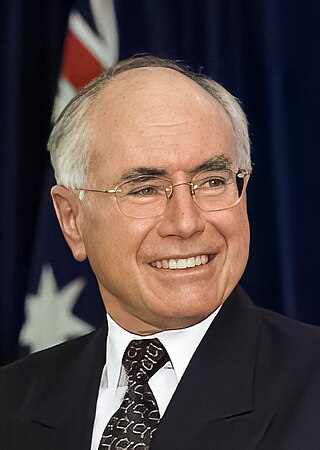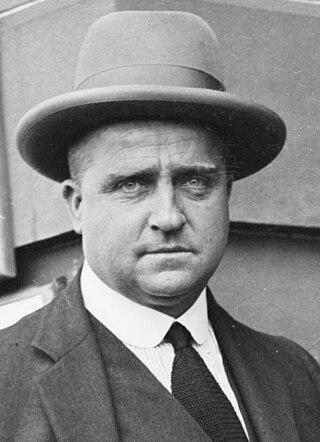
The 2001 Australian federal election was held in Australia on 10 November 2001. All 150 seats in the House of Representatives and 40 seats in the 76-member Senate were up for election. The incumbent Liberal Party of Australia led by Prime Minister of Australia John Howard and coalition partner the National Party of Australia led by John Anderson defeated the opposition Australian Labor Party led by Kim Beazley. As of 2024, this was the most recent election to feature a rematch of both major party leaders. Future Opposition Leader Peter Dutton entered parliament at this election.

Edward John Ward was an Australian politician who represented the Australian Labor Party (ALP) in federal parliament for over 30 years. He was the member for East Sydney for all but six and a half weeks from 1931 until his death in 1963. He served as a minister in the Curtin and Chifley governments from 1941 to 1949, and was also known for his role in the ALP split of 1931.

William Arthur Holman was an Australian politician who served as Premier of New South Wales from 1913 to 1920. He came to office as the leader of the Labor Party, but was expelled from the party in the split of 1916. He subsequently became the inaugural leader of the NSW branch of the Nationalist Party.

Lang Labor was a faction of the Australian Labor Party (ALP) consisting of the supporters of Jack Lang, who served two terms as Premier of New South Wales and was the party's state leader from 1923 to 1939. It controlled the New South Wales branch of the ALP throughout most of the 1920s and 1930s. The faction broke away to form separate parliamentary parties on several occasions and stood competing candidates against the ALP in state and federal elections.
Alick Dudley Kay was an Australian politician and Domain orator. He is described by the Australian Dictionary of Biography as a "harmless ratbag".
The Australian Labor Party (Non-Communist), which operated from 1940 to 1941, was a breakaway from the Australian Labor Party (ALP), and was associated with the Lang Labor faction and former New South Wales premier Jack Lang.

William Victor "Big Bill" McCall was an Australian politician and businessman. He was a member of the United Australia Party (UAP) and held the seat of Martin in the House of Representatives from 1934 to 1943.

John Joseph Clasby was an Australian politician.
This is a list of the members of the Australian House of Representatives in the 13th Australian Parliament, which was elected at the 1931 election on 19 December 1931. The incumbent Australian Labor Party led by Prime Minister of Australia James Scullin was defeated by the newly formed opposition United Australia Party led by ex-Labor Joseph Lyons with coalition partner the Country Party led by Earle Page.
This article provides information on candidates who stood for the 1931 Australian federal election. The election was held on 19 December 1931.
This article provides information on candidates who stood for the 1934 Australian federal election. The election was held on 15 September 1934.

The 2011 New South Wales state election held on Saturday, 26 March 2011. The 16-year-incumbent Labor Party government led by Premier Kristina Keneally was defeated in a landslide by the Liberal–National Coalition opposition led by Barry O'Farrell.

The 1932 New South Wales state election was held on 11 June 1932. This election was for all of the 90 seats in the 30th New South Wales Legislative Assembly and it was conducted in single member constituencies with compulsory preferential voting. It was a landslide victory for the UAP/Country Party coalition of Bertram Stevens, which had a majority of 42 in the Assembly.

The 1947 New South Wales state election was held on 3 May 1947. It was conducted in single member constituencies with compulsory preferential voting and was held on boundaries created at a 1940 redistribution. The election was for all of the 90 seats in the Legislative Assembly.
A by-election was held for the Australian House of Representatives seat of East Sydney on 7 March 1931. This was triggered by the death of Labor MP John West.
The history of the Australian Labor Party has its origins in the Labour parties founded in the 1890s in the Australian colonies prior to federation. Labor tradition ascribes the founding of Queensland Labour to a meeting of striking pastoral workers under a ghost gum tree in Barcaldine, Queensland in 1891. The Balmain, New South Wales branch of the party claims to be the oldest in Australia. Labour as a parliamentary party dates from 1891 in New South Wales and South Australia, 1893 in Queensland, and later in the other colonies.

The Australian Labor Party split of 1931 was caused by severe divisions within the Australian Labor Party (ALP) over its economic response to the Great Depression. Amidst intense disagreement between economically conservative and radical elements of the party, two senior ministers in the Scullin Labor government, Joseph Lyons and James Fenton, resigned from Cabinet in January 1931. Lyons, Fenton and their supporters would subsequently merge with the conservative opposition Nationalist Party to form the new United Australia Party (UAP), led by Lyons with the last Nationalist leader, John Latham, as his deputy.

The Territory Labor Party, officially known as the Australian Labor Party (Northern Territory Branch) and commonly referred to simply as Territory Labor, is the Northern Territory branch of the Australian Labor Party. It has been led by Selena Uibo, the first Aboriginal woman to lead a major political party in Australia, since 3 September 2024.
The Federal Labor Party were the members of the Australian Labor Party in the state of New South Wales who supported the federal party leadership in the split with the state Labor party which broke away in 1931. Federal Labor retained some seats in the Parliament of Australia but was a minor party in state elections. The dispute was healed in 1936.

The 2023 New South Wales state election was held on 25 March 2023 to elect the 58th Parliament of New South Wales, including all 93 seats in the Legislative Assembly and 21 of the 42 seats in the Legislative Council. The election was conducted by the New South Wales Electoral Commission (NSWEC).













